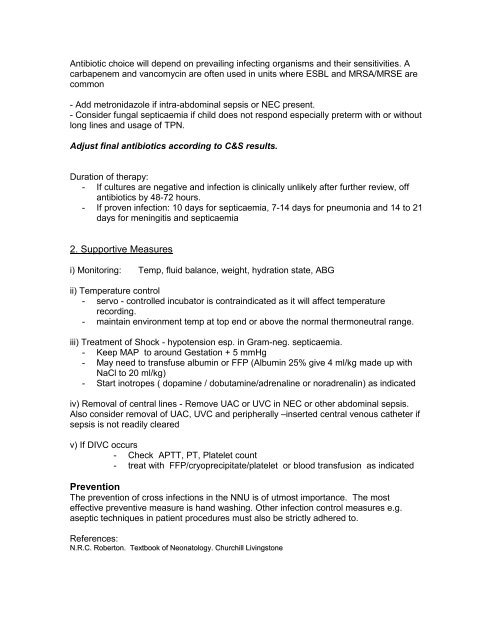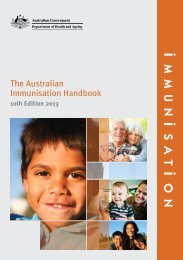Contents Chapter Topic Page Neonatology Respiratory Cardiology
Contents Chapter Topic Page Neonatology Respiratory Cardiology
Contents Chapter Topic Page Neonatology Respiratory Cardiology
You also want an ePaper? Increase the reach of your titles
YUMPU automatically turns print PDFs into web optimized ePapers that Google loves.
Antibiotic choice will depend on prevailing infecting organisms and their sensitivities. A<br />
carbapenem and vancomycin are often used in units where ESBL and MRSA/MRSE are<br />
common<br />
- Add metronidazole if intra-abdominal sepsis or NEC present.<br />
- Consider fungal septicaemia if child does not respond especially preterm with or without<br />
long lines and usage of TPN.<br />
Adjust final antibiotics according to C&S results.<br />
Duration of therapy:<br />
- If cultures are negative and infection is clinically unlikely after further review, off<br />
antibiotics by 48-72 hours.<br />
- If proven infection: 10 days for septicaemia, 7-14 days for pneumonia and 14 to 21<br />
days for meningitis and septicaemia<br />
2. Supportive Measures<br />
i) Monitoring: Temp, fluid balance, weight, hydration state, ABG<br />
ii) Temperature control<br />
- servo - controlled incubator is contraindicated as it will affect temperature<br />
recording.<br />
- maintain environment temp at top end or above the normal thermoneutral range.<br />
iii) Treatment of Shock - hypotension esp. in Gram-neg. septicaemia.<br />
- Keep MAP to around Gestation + 5 mmHg<br />
- May need to transfuse albumin or FFP (Albumin 25% give 4 ml/kg made up with<br />
NaCl to 20 ml/kg)<br />
- Start inotropes ( dopamine / dobutamine/adrenaline or noradrenalin) as indicated<br />
iv) Removal of central lines - Remove UAC or UVC in NEC or other abdominal sepsis.<br />
Also consider removal of UAC, UVC and peripherally –inserted central venous catheter if<br />
sepsis is not readily cleared<br />
v) If DIVC occurs<br />
- Check APTT, PT, Platelet count<br />
- treat with FFP/cryoprecipitate/platelet or blood transfusion as indicated<br />
Prevention<br />
The prevention of cross infections in the NNU is of utmost importance. The most<br />
effective preventive measure is hand washing. Other infection control measures e.g.<br />
aseptic techniques in patient procedures must also be strictly adhered to.<br />
References:<br />
N.R.C. Roberton. Textbook of <strong>Neonatology</strong>. Churchill Livingstone
















